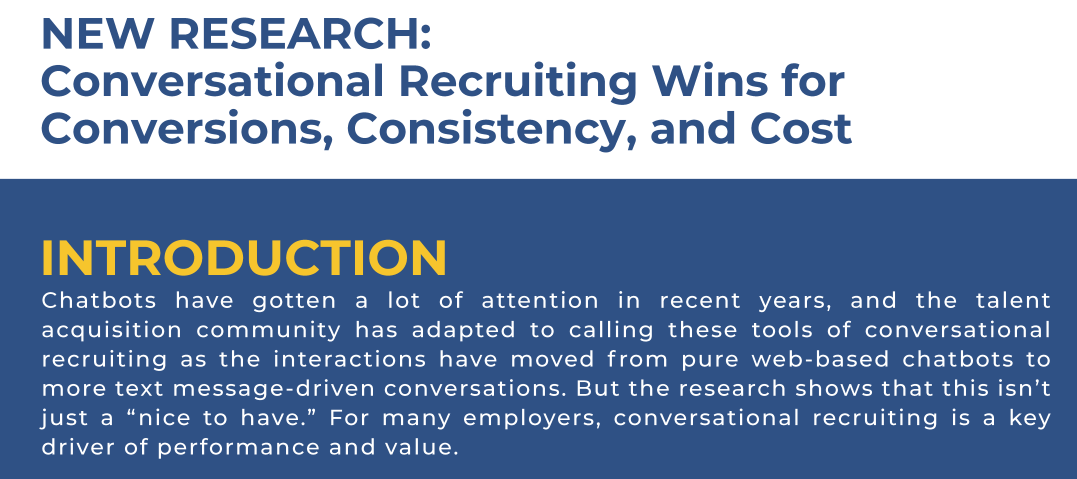Chatbots, also known as conversational recruiting tools, have become an essential component for the hiring technology stack at many organization. Used for everything from capturing information and light prescreening of candidates to scheduling interviews and more, these tools have a variety of applications across the hiring process.
But new research shows that usage and value of these tools goes deeper. The longer a company uses chatbots, automation, and other AI-based hiring tools, the more they evolve. In the infographic below you’ll see some of those key evolutionary components.
Those employers using chatbots and conversational recruiting for 2+ years are:
- 2X MORE LIKELY to prioritize relationship skills when upskilling recruiting teams
- MORE LIKELY to say conversational recruiting tools are a key part of the talent acquisition toolbox and enable better recruiter performance.
- 50% MORE LIKELY to see improvements in efficiency
- 5X MORE LIKELY to be spending time on metrics, measurement, business impact
Note that while this piece is primarily focused on chatbots, this research finding also includes other areas of recruiting automation as well. The same findings may hold true for HR and learning teams as well, if we’re able to gather data to understand those areas more fully in our coming research.
Want to go deeper? Check out some of the following related resources:
-
Report: Recruiter skill gaps, internal mobility, and other key TA priorities
-
Event replay on demand: The State of Hiring, featuring a keynote with two VPs of Talent
Download the PDF version of the graphic: LHRA Graphic Conversational Recruiting Three C’s 2021
Infographic Transcript:
NEW RESEARCH: Conversational Recruiting Wins for Conversions, Consistency, and Cost
Chatbots have gotten a lot of attention in recent years, and the talent acquisition community has adapted to calling these tools of conversational recruiting as the interactions have moved f rom pure web-based chatbots to more text message-driven conversations. But the research shows that this isn’t just a “nice to have.” For many employers, conversational recruiting is a key
driver of performance and value.
A key facet of our research hypothesis was that those companies new to conversational recruiting would have different perspectives than those more mature users. This turned out to be true in many respects.
ABOUT THE RESEARCH
About the 2021 Talent Acquisition Priorities research: Q1 2021 survey of 800+ talent acquisition leaders primarily based in North America representing a variety of industries and company sizes.
The need to hire virtually over the last year may have been brought on with little notice, but it’s become a key staple of the modern organization’s approach to hiring by reducing costs, increasing access to talent, and driving a more focused partnership with the business. For teams that want to remain agile and resilient to change, conversational recruiting offers a powerful way to connect with candidates and drive the right outcomes from a recruiting perspective.
KEY FEATURES AND OUTCOMES OF CONVERSATIONAL RECRUITING TOOLS
KEY FEATURES
- CAPTURE CANDIDATE INFORMATION AND SIMPLIFY APPLY PROCESS
- PREQUALIFY CANDIDATES WITH SCREENING QUESTIONS
- SCHEDULE INTERVIEWS AND SEND REMINDERS
- FOLLOW UP POSTHIRE TO CHECK ON SATISFACTION AND FURTHER NEEDS
KEY OUTCOMES
- 91% INCREASE IN COMPLETED APPLICATIONS
- 2/3 OF INTERACTIONS HAPPEN OUTSIDE NORMAL BUSINESS HOURS
- 85% DECREASE IN TIME SPENT SCHEDULING INTERVIEWS
- 40% MORE CANDIDATES COMPLETE THE APPLICATION PROCESS
- 92% INCREASE IN CANDIDATE SATISFACTION
CONVERSATIONAL RECRUITING MATURITY
Those using chatbots and conversational recruiting for 2+ years are
- 2X MORE LIKELY to prioritize relationship skills when upskilling recruiting teams
- MORE LIKELY to say conversational recruiting tools are a key part of the talent acquisition toolbox and enable better recruiter performance.
- 50% MORE LIKELY to see improvements in efficiency
- 5X MORE LIKELY to be spending time on metrics, measurement, business impact
TECHNOLOGY LANDSCAPE: CONSOLIDATION IS TRENDING
PAST
Two years ago, more than 26 different providers offered chatbots for hiring. Key acquisitions and exits since then have shrunk that number considerably.
PRESENT
Today, a smaller group of key players exist as standalone conversational recruiting solutions. In addition, many enterprise talent acquisition providers have either acquired or built their own solutions to support this need
FUTURE
Going forward, the priority for conversational recruiting tools will be integrating with key elements of the recruiting tech stack, including applicant tracking systems, recruitment marketing tools, assessments, and more.

Ben Eubanks is the Chief Research Officer at Lighthouse Research & Advisory. He is an author, speaker, and researcher with a passion for telling stories and making complex topics easy to understand.
His latest book Talent Scarcity answers the question every business leader has asked in recent years: “Where are all the people, and how do we get them back to work?” It shares practical and strategic recruiting and retention ideas and case studies for every employer.
His first book, Artificial Intelligence for HR, is the world’s most-cited resource on AI applications for hiring, development, and employee experience.
Ben has more than 10 years of experience both as an HR/recruiting executive as well as a researcher on workplace topics. His work is practical, relevant, and valued by practitioners from F100 firms to SMB organizations across the globe.
He has spoken to tens of thousands of HR professionals across the globe and enjoys sharing about technology, talent practices, and more. His speaking credits include the SHRM Annual Conference, Seminarium International, PeopleMatters Dubai and India, and over 100 other notable events.


